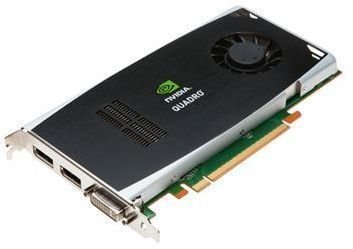Video Editing Graphics Card - Buying Guide
Shopping For Graphics Card
First and foremost, a graphics card should support what you need it for; especially when working with video editing, you’ll need something fast.
There are 3 different types of graphic cards:
AGP cards, PCI cards, and PCIe cards (Accelerated Graphics Port and Peripheral Component Interconnect/ Express. PCIe being the newest.).
PCIe cards work best with video editing since these types of graphics cards have two slot (versus the AGP motherboard which only supports one), giving the user capability to insert more graphic cards for a faster video editing experience. Also, you can insert smaller cards into the larger slots.
The NVIDIA Quadro FX 1800 offers high-performance for video editing and animation.
When shopping for a graphics card, consider the following:
- Your computer’s minimum graphics memory requirement
- Slot on your motherboard (AGP or PCI, PCI-e)
- The memory bandwidth of the graphics card (the speed, e.g. PCIe: 1x, 4x, 8x, 16x and 32x; AGP up to 8x)
- The memory size of the graphics card
- Price range
- Reviews, opinions, etc.
You need a graphics card with a fast speed, generally somewhere in between 500MHz and 1 GHz is ideal. Also, make sure the memory size is at least between 256 MB to 1GB - anything shorter will interfere with your computer’s memory, and won’t run as efficiently. The more memory, the faster it is.
Choose a high-performance graphics card, and look at the ones professional graphic artists/ animators use. There are several online sites that offer reasonable rates, reviews, etc. of these types of cards (see list below).
Compare prices and weigh out the odds. Visit the manufacturers sites and browse through other stores that sell graphic cards. You may be surprised to find some sites offer the same product for less.
Don’t forget to read the user reviews. If the company and/or product has a bad reputation for not meeting the needs of its consumers, obviously you’ll save yourself the time, money, and trouble by simply looking elsewhere.
Other considerations when shopping for a graphics card:
- Keep in mind, a new and faster graphics card will need additional power; that’s why newer ones have to be directly plugged into a DC wall outlet
- The graphic card’s frame rate should be fast–60 FPS (frames per second).
- Choose a model with DVI (digital video interface)
- A duel-head graphics card will support the ability to hook up two monitors (useful if you need an extra monitor/s when editing/ graphics/ 3D animation)
Sites:
AMD (Advanced Micro Devices)
https://www.amd.com/us/Pages/AMDHomePage.aspx
Nvidia
https://www.nvidia.com/page/home.html
Asus graphic cards
[https://usa.asus.com/ProductGroup2.aspx?PG_ID=r3EWBZcGQvxHvrb4ENGTX260 TOP/HTDI/896M 13% faster](https://usa.asus.com/ProductGroup2.aspx?PG_ID=r3EWBZcGQvxHvrb4 ENGTX260 TOP/HTDI/896M 13% faster)
Compare Shopping Sites: (links directly to graphic cards)
Bizrate
[https://www.bizrate.com/graphics-cards/](/tools/Bizrate http:/www.bizrate.com/graphics-cards/ MySimon: http:/www.mysimon.com/ Nextag http:/www.nextag.com/Graphics–zz300249zB4z5—html Pronto Tech http:/www.prontotech.com/graphics-cards Shopzilla http:/www.shopzilla.com/graphics-cards/405/products Smarter.com http:/www.smarter.com/graphics-cards/pl–ch-2–ca-308.html TigerDirect.com http:/www.tigerdirect.com/applications/Category/category_tlc.asp?CatId=28&SRCCODE=WEBGOOVID&cm_mmc_o=mH4CjC7BBTkwCjCECjCE)
MySimon:
Nextag
https://www.nextag.com/Graphics–zz300249zB4z5—html
Pronto Tech
